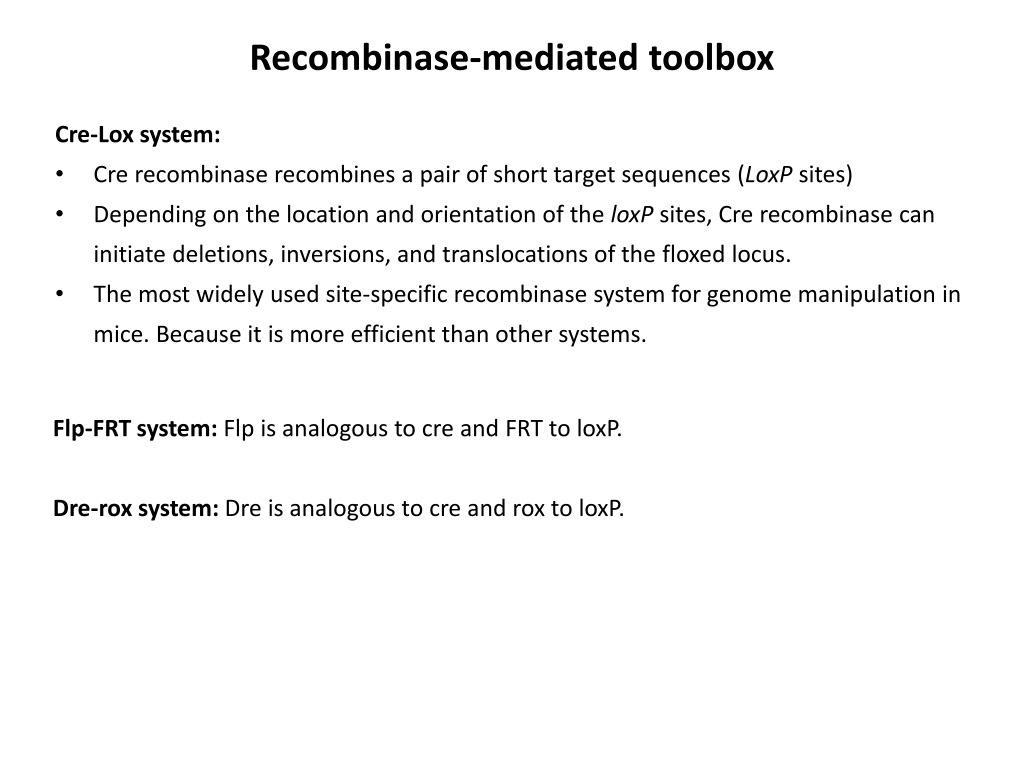Understanding the Cre-Lox System for Genome Manipulation in Mice
The Cre-Lox system, a powerful tool in genetic engineering, employs Cre recombinase to recombine specific DNA sequences (LoxP sites), allowing for precise genetic modifications such as deletions, inversions, and translocations. This system enables conditional gene expression, turning on or off transgenes in a spatially and temporally controlled manner. By strategically incorporating LoxP sites flanking a transgene, researchers can regulate gene expression with high precision, offering valuable insights into gene function and disease modeling in mice.
Download Presentation

Please find below an Image/Link to download the presentation.
The content on the website is provided AS IS for your information and personal use only. It may not be sold, licensed, or shared on other websites without obtaining consent from the author. Download presentation by click this link. If you encounter any issues during the download, it is possible that the publisher has removed the file from their server.
E N D
Presentation Transcript
Recombinase-mediated toolbox Cre-Lox system: Cre recombinase recombines a pair of short target sequences (LoxP sites) Depending on the location and orientation of the loxP sites, Cre recombinase can initiate deletions, inversions, and translocations of the floxed locus. The most widely used site-specific recombinase system for genome manipulation in mice. Because it is more efficient than other systems. Flp-FRT system: Flp is analogous to cre and FRT to loxP. Dre-rox system: Dre is analogous to cre and rox to loxP.
Recombinase-mediated toolbox Cre-Lox system Cre recombinase recombines a pair of short target sequences (LoxP sites) Depending on the location and orientation of the loxP sites, Cre recombinase can initiate deletions (A), inversions (B), and translocations (C) of the floxed locus. The most common reference: Nagy A 2000, Genesis image from https://www.jax.org/news-and-insights/2006/may/the-cre-lox-and-flp-frt-systems
Use the Cre-Lox system to express a transgene Cre recombinase removes the stop sequence, so the transgene is expressed only in the cells where Cre is active images from https://www.jax.org
Use the Cre-Lox system to express a transgene Cre recombinase removes the stop sequence, so the transgene is expressed only in the cells where Cre is active images from https://www.jax.org
Use the Cre-Lox system to turn off a transgene A transgene is designed with loxP sites flanking all or part of it. So the transgene is turned off only in the cells where Cre is active ~50% of the offspring will be heterozygous for the loxP allele and heterozygous for the cre transgene. images from https://www.jax.org
Use the Cre-Lox system to turn off a transgene A transgene is designed with loxP sites flanking all or part of it. So the transgene is turned off only in the cells where Cre is active Mate heterozygous mice from the 1stgeneration back to the homozygous loxP-flanked mice. Experimental mice (~25%): homozygous for the loxP-flanked allele and heterozygous for the cre transgene images from https://www.jax.org
Inducibility: allows temporal control of gene manipulation The tamoxifen-inducible cre alleles: the most common inducible Cre variety. Cre is expressed as a fusion protein with a modified estrogen receptor (ER) ligand binding domain. Binding to tamoxifen allows the Cre-ER fusion protein to translocate to the nucleus where the recombinase takes effect. The RU-486 inducible cre alleles: : cre is expressed as a fusion protein with a modified progesterone receptor, allowing induction with the progesterone analog RU-486. The TMP-inducible cre alleles: cre is expressed as a fusion protein with a modified E. coli dihydrofolate reductase (DHFR) protein, which can be induced by the common antibiotic trimethoprim (TMP).
Use multiple recombinases for sophisticated manipulation As Cre, Flp, and Dre recognize different target sequences, the combined use of these recombinases would facilitate more sophisticated genetic manipulation of restricted cell populations. Example1: Intersectional control by either Cre/Flp or Cre/Dre recombinases, driven by different promoters (P1 or P2), on a doubly regulated reporter line. Reference: Madisen L et al., 2015 Neuron; Imayoshi I et al., 2011 Front. Neurosci.
Use multiple recombinases for sophisticated manipulation Example2: express tdTomato for Cre NOT Flp subtraction and GFP for Cre AND Flp intersection. FRT FRT LoxP LoxP Example3: convert a transient Cre expression to a permanent Flp expression. Reference: He M et al., 2016 Neuron























